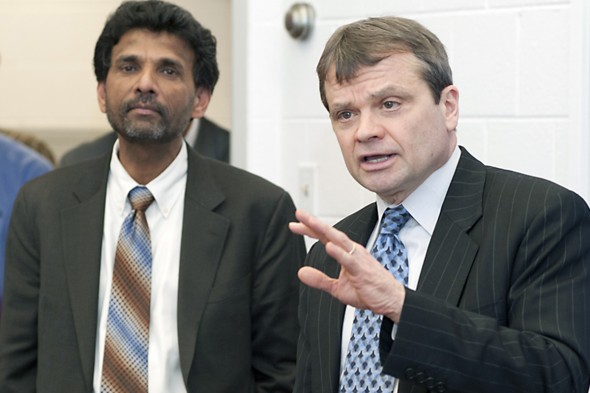Congressman looks closer at UIC technology

Rep. Mike Quigley talks with students and researchers at the Microphysics Lab headed by Siva Sivananthan, left. Photo: Roberta Dupuis-Devlin/UIC Photo Services
How would you hide from night vision? U.S. Rep. Mike Quigley wanted to know.
Not interested in just touring the Microphysics Lab and congratulating physics professor Siva Sivananthan on his lab’s extraordinary work, Quigley, congressman for Illinois’ 5th District, wanted to understand the science.
The lab’s work with a semiconductor material, mercury cadmium telluride or MCT, is at the heart of night vision technology used by the U.S. military.
Since 1982, the Microphysics Lab has built connections to government and industry as a center for basic and applied physics research with an emphasis on materials and devices for infrared sensing, imaging and, most recently, photovoltaic (solar power) cells.
Because, at its most fundamental, MCT technology is about transforming light into electricity, Sivananthan is leading an effort to make Illinois a leader in the development of solar power.
Graduates of his lab are in high demand in both government and industry, but Sivananthan is interested in every level of education.
The lab sponsors INSPIRE, an organization of undergraduate and graduate students dedicated to introducing high school students to science through hands- on learning. The group’s projects include a speaker series and a do-it-yourself solar panel project kit put together from scavenged broken solar cells.
Quigley commended the team’s passion and imagination. He also suggested they form a “truth squad,” speaking out whenever they encounter people in government or the media who misrepresent science.
“We can’t let them get away with it,” he said.
Quigley’s lab tour concluded with a presentation from three students from Benito Juarez High School, where the microphysics lab has an ongoing partnership and recently helped a student team with an entry for a robot competition.
The students, Martha Martinez, Jose Sanchez and Michael Martinez, presented their solar-powered robot and spoke about how working on the team had inspired them. All three hope to pursue careers in science or health care.
The answer to Quigley’s question?
Hiding from night vision technology would take enormous effort, sophistication and expense. But even then, it would be impossible to hide the wealth of information the technology can reveal.
